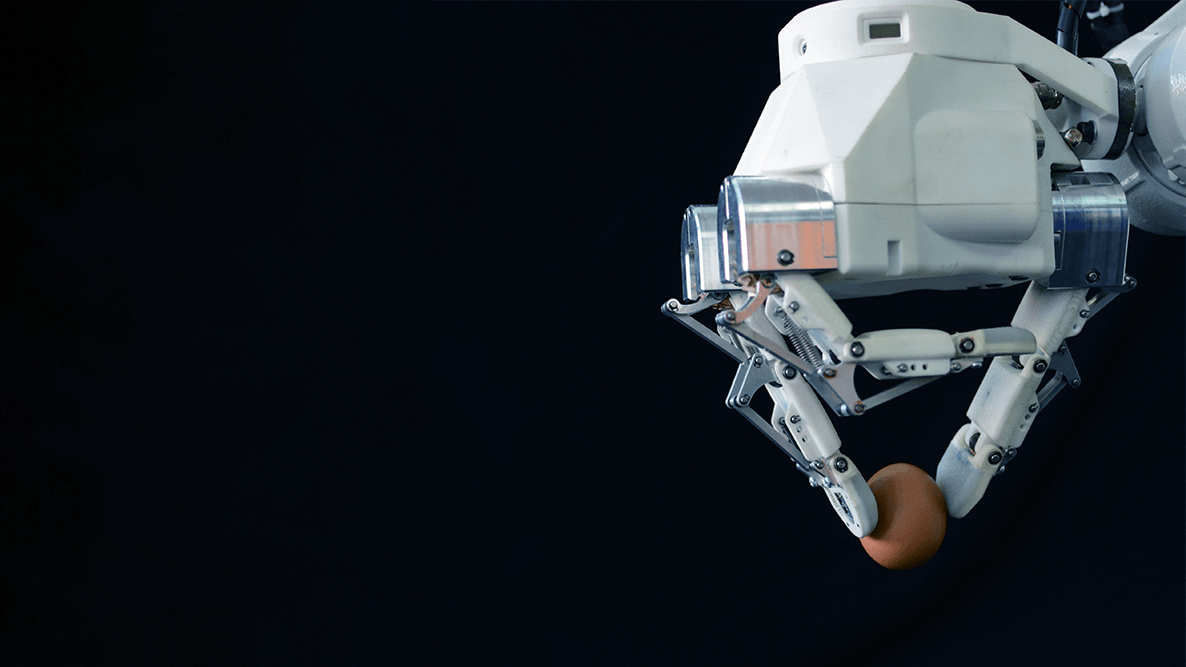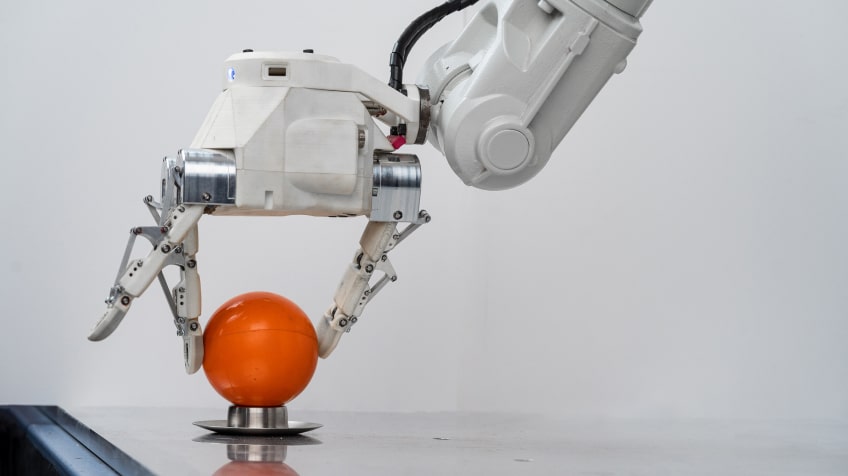Robotics, artificial intelligence (AI), and the Internet of Things (IoT) are key technologies in the mission to redefine businesses and help free people from tedious tasks.
Robots are critical in this mission as they help increase safety, reduce costs, increase efficiency, enhance productivity, address labor shortages, and perform routine tasks.
Motivated by our commitment to choosing projects that make a groundbreaking impact on the world, we decided to collaborate with other experts to develop a flexible robotic hand.
In collaboration with the Faculty of Technical Sciences (the University of Novi Sad), the Faculty of Electronic Engineering (University of Nis), and the company Sigmoid, and powered by the Innovation Fund in Serbia, we created a soft-grab three-finger robotic hand designed for use in warehouses and manufacturing.
The idea for this project came from Ph.D., Mirko Rakovic, Associate Professor of Robotics at FTN, and a co-founder of Sigmoid doo. We recently talked with Mirko Rakovic about how this robotic hand idea was born, the partnership between HTEC Group and his company, and the decision to apply for funding from the EU.
You are a co-founder of Sigmoid, an innovative company from Novi Sad. Can you tell us a little bit more about what you do?
“The company was established in 2017, so we are a startup and still a small company growing with partners such as HTEC Group. Our main focus is directed toward robotics and software development. All our clients are doing business in the fields focused on those two areas. We work on software development and product development for different robotic applications, software development for various clients, and on development of our own software products.”
How was the idea for building a robotic hand born?
“So, I am coming from academia. I am a robotics professor and am passionate about robotics in general. I follow everything that is happening in robotics. One of the main bottlenecks for flexible automation is the ability to replicate the same flexibility of what the human hand can do in terms of dexterity and combine it with the precision and repeatability of robotic arms.
The technology of robotic arms has already advanced to the point where there are no longer significant improvements. However, the robotic hand’s dexterity and ability to manipulate different shapes of different sizes and weights are still a problem.
So usually when we have a robotic application, we also have a design of a dedicated robotic hand or a gripper or a tool to perform specific activities. We are coming to the point where robotic hands and arms can manipulate various objects. We wanted to answer that challenge and come up with a hand that can pick a small box and also manipulate a bottle of liquid or soft fruits and vegetables. We wanted to be a step closer to the capabilities of the human hand. This is what we identified as a gap, and what motivated us to develop this idea.”
This was done in collaboration with the universities in Novi Sad and Nis. So how did the collaboration go?
“As you know, I’m a co-founder of Sigmoid, and I work as an associate professor of robotics at the faculty of technical sciences in Novi Sad. I have a team in my company, but I also work with a team of my colleagues at the faculty.
“This is half of the story. I’m also collaborating with Darko Todorovic from HTEC, a director of engineering and delivery, who is very much connected with the faculty of electronics engineering from Nis. So, the other half of the story comes from Darko. He brought in HTEC and faculty from Nis. This is how the consortium was established. The project requires a lot of research as well. So, we included young researchers from the universities backed up by industry-oriented engineers.
As a result of our discussions, we applied for the Innovation Fund, which promotes collaboration between industry partners and university partners. This allowed us to prepare the project proposal.”
Why did you choose HTEC to work on this project?
“I met Darko at the University of Nis. We talked about what we were working on and identified a potential client whose main challenge was how to manipulate various objects. I already told them about our previous project where we designed a five-finger hand similar to the human hand. As a result, we merged these two stories into one.
One of the important aspects of the robotic hand is a sensor that is at the fingertips of each finger. The innovation of the project is built around this idea, and this is how we evolved into a consortium for developing a flexible robotic hand.”
So, you had a commercial application in mind from the start?
“Yes, from the beginning, we had a market that we were focused on—a flexible robotic hand. We researched competition and identified that there is room for another product that could compete.”
How close are you to bringing this product to the market right now?
“We definitely see room for improvements, but initial expectations on the technical side are already met. There is a grade for technology readiness level in the EU from one to 10, and I think we are somewhere between eight and nine. So, we will definitely need to do one more redesign before batch manufacturing. Right now, the parts are designed for small batches, for a few pieces to be manufactured, and we can’t say much about a high-volume production at this stage.”
What was the biggest challenge you had to overcome during the project and how did you solve it?
“Well, robotics is a multidisciplinary area. You have to combine software, hardware, and mechanical parts and they need to breathe as one system. If we fail in mechanics, we cannot fix it with software, and vice versa.
One of the challenges was to carefully push all the critical components of the system in parallel, not to fail on any of those. We had to make good progress in the design of electronics, which was done by the HTEC Group. Then we had to push proper design in mechanics and manufacturing of all the parts, which was done by the FTS and Sigmoid. We had to push software development, which was done by Sigmoid with support from the faculty of electronics at the University of Nis.
So, the main problem or main issue was to ensure that all the pieces were progressing well. It was a joint effort. In this stage of development, we didn’t outsource the assembly because this had to be done by the designers themselves. They had this in mind while designing.”

Tell us more about the robotic hand. What range of motion does it have, and how reliably does it operate?
“We did a few first grasps that showed the ability of the hand to grasp objects of weight of up to four kilograms. The hand itself is designed as a three-finger hand. We analyzed the minimum number of fingers that we needed to cover several basic grasps that humans can perform. Those are power grasp or ball grasp, then cylindrical grasp, etc.
We identified finger movements and the number of fingers needed to cover all the basic types of human grasps. We concluded that three fingers are good enough. One finger, the thumb, can rotate compared to the other two fingers. Each finger has three segments that can adapt their shape around the object being grasped. Thus, we are able to grasp objects of different and irregular shapes.”
How did HTEC help bring this solution to life?
“HTEC was very important to us. We did not have competencies in designing industrial grade electronics. On the other hand, HTEC has experience in designing electronics for robotics, for motor control, etc.
It was a mix of experiences. We brought to the table all our knowledge regarding controlling motors, interfacing encoders, and other details related to electronics for robotic applications. HTEC brought their extensive experience in very fast design that follows all the necessary checks on the availability of the components and manufacturing, while taking care of all the standards related to the PCB that satisfy certification. We brought skills in motor control and software that is needed to run on that PCB. It was a mixed quest.”
What makes this robotic hand stand out from similar solutions on the market?
“We started with a design of the fingers that have sensors at their fingertips, which is important for grasp control. If you are grasping an object, sometimes you don’t need vision, but you need a sense of touch.
Our hand is designed with sensors at each fingertip. These sensors provide feedback information about the contact force and its location. This gives us information about whether we have grasped the object properly so that we can safely manipulate it in the environment. Other hands usually use feedback from motors, which is not good enough.”
Is this robotic hand a cheaper option than its competitors?
“That’s true. It’s a cheaper option. But when we are talking about sensing capabilities, it actually provides richer information. Others can measure one component of the force — they actually do not measure the force; they are estimating it from the current of the motor. We are measuring the force at the point where it appears.
For instance, if you are holding a cup, are you measuring the contact force by the used strength of the muscle in the arm or by feeling it from the fingertip? We are definitely not measuring from the used strength of the muscle. Also, you cannot measure the location of the force. With our sensors in the fingertip, we are providing richer information that gives us insights into the quality of the grasp. We successfully demonstrated that we can grasp different objects in size and shape and move them from one place to another.
Now, we are in the phase of assembling a second version of the prototype with better mechanical components. The goal is to have new demos and new use cases by the end of August this year.”
How do you think the robotic hand will impact the industry?
“A hand can be used for applications that require simple grasps and applications that require flexibility. ‘Pick and place’ operation is the most widely used application in robotics.
If we have a production line where we have different products coming on the line, we prefer to have a robotic hand that can manipulate each of them. Another interesting application could be machine tending. If a company is manufacturing metal parts with various shapes, a robotic hand that can manipulate all of the objects with one tool, i.e. hand, would easily increase the level of automation in the production process.
The conclusion is that our hand can be used for different applications—for example, you require a robot with a hand to pick and manipulate objects of different shapes and weights.”
What would you say is the ultimate business benefit of the robotic hand?
“Clients do not want to buy a technology that will not do the job for them. We want to develop a business model that will simplify clients’ decisions for investing in automation by charging for what the robotic hand has accomplished, i.e. a charge per outcome.”
Do you plan to partner with HTEC on any other projects in the future?
“We are already collaborating on one project, and I’m sure that our future collaboration will bring a lot of value and great results, not only to us but also to our future clients.”
Want to learn more about how HTEC’s technology expertise can transform your business? Explore our
Product Engineering and
Industrial & Robotics capabilities.







